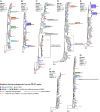HIV-1 control in vivo is related to the number but not the fraction of infected cells with viral unspliced RNA
- PMID: 39190360
- PMCID: PMC11388345
- DOI: 10.1073/pnas.2405210121
HIV-1 control in vivo is related to the number but not the fraction of infected cells with viral unspliced RNA
Abstract
In the absence of antiretroviral therapy (ART), a subset of individuals, termed HIV controllers, have levels of plasma viremia that are orders of magnitude lower than non-controllers (NC) who are at higher risk for HIV disease progression. In addition to having fewer infected cells resulting in fewer cells with HIV RNA, it is possible that lower levels of plasma viremia in controllers are due to a lower fraction of the infected cells having HIV-1 unspliced RNA (HIV usRNA) compared with NC. To directly test this possibility, we used sensitive and quantitative single-cell sequencing methods to compare the fraction of infected cells that contain one or more copies of HIV usRNA in peripheral blood mononuclear cells (PBMC) obtained from controllers and NC. The fraction of infected cells containing HIV usRNA did not differ between the two groups. Rather, the levels of viremia were strongly associated with the total number of infected cells that had HIV usRNA, as reported by others, with controllers having 34-fold fewer infected cells per million PBMC. These results reveal that viremic control is not associated with a lower fraction of proviruses expressing HIV usRNA, unlike what is reported for elite controllers, but is only related to having fewer infected cells overall, maybe reflecting greater immune clearance of infected cells. Our findings show that proviral silencing is not a key mechanism for viremic control and will help to refine strategies toward achieving HIV remission without ART.
Keywords: CARD-SGS; HIV RNA; HIV controllers; HIV latency; HIV proviral expression.
Conflict of interest statement
Competing interests statement:J.W.M. is a consultant to Gilead Sciences, has received research grants from Gilead Sciences to the University of Pittsburgh, and owns share options in Infectious Disease Connect (co-founder) and Galapagos, NV, unrelated to the current work on HIV. J.M.C. is a member of the Scientific Advisory Board and a Shareholder of ROME Therapeutics, Inc. and Generate Biomedicine, Inc., both unrelated to the current work on HIV.
Figures







Update of
-
HIV-1 control in vivo is related to the number but not the fraction of infected cells with viral unspliced RNA.bioRxiv [Preprint]. 2024 Jul 2:2024.07.01.601579. doi: 10.1101/2024.07.01.601579. bioRxiv. 2024. Update in: Proc Natl Acad Sci U S A. 2024 Sep 3;121(36):e2405210121. doi: 10.1073/pnas.2405210121. PMID: 41031000 Free PMC article. Updated. Preprint.
References
-
- Mellors J. W., et al. , Prognosis in HIV-1 infection predicted by the quantity of virus in plasma. Science 272, 1167–1170 (1996). - PubMed
-
- O’Brien W. A., et al. , Changes in plasma HIV-1 RNA and CD4+ lymphocyte counts and the risk of progression to AIDS. Veterans Affairs Cooperative Study Group on AIDS. N. Engl. J. Med. 334, 426–431 (1996). - PubMed
-
- Sannier G., et al. , Combined single-cell transcriptional, translational, and genomic profiling reveals HIV-1 reservoir diversity. Cell Rep. 36, 109643 (2021). - PubMed
MeSH terms
Substances
Grants and funding
LinkOut - more resources
Full Text Sources
Medical
Molecular Biology Databases

